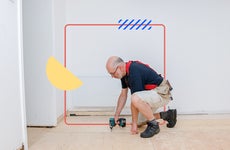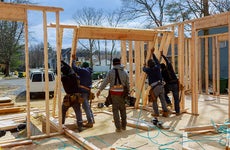How much does it cost to add a second story to your home?

The Bankrate promise
At Bankrate we strive to help you make smarter financial decisions. While we adhere to strict , this post may contain references to products from our partners. Here's an explanation for .
If your house is too small for your needs, you have two choices: move to a larger home or add to it.
Neither option is stress-free. But, given the current state of the residential real estate market — high prices and low inventory — many homeowners might prefer to make the addition instead of moving.
Adding a second story to a house isn’t that different from building a new house, at least from the builder’s perspective, according to Gary Henley, president of Henley Homes, a home remodeling company in Liberty Hill, Texas. New construction is simply placed over the structure’s existing footprint, he explains.
Even so, an extra floor raises a lot of issues, from structural soundness and building codes to stairway access and occupancy during construction. And it’s one of the most expensive renovations you can make to a home. Let’s look at the cost of a second-floor addition and what’s involved in this project.
How much does it cost to add a second story to a home?
Adding on a second story to a house isn’t cheap. Of course, there’s an near-infinite variety of factors influencing the final price tag. Builders say the cost of a project depends on its scope and scale, the quality of materials and finishes the homeowner selects, and local labor costs.
While a typical home addition can cost between $21,000 and $74,000, when you add a second story to a house, you have to tackle several specific tasks: upgrading the house’s foundation, adding supports, and removing and replacing your home’s roof. All this, on top of actually building the addition.
So, how much does it cost? All told, the cost to add a second story usually runs between $300 and $500 per square foot, making a typical project cost $150,000–$200,000 for 1,000-sq.-ft. homes, according to contractor search site Fixr. For smaller houses, figure on $90,000 to $120,000. Of course, pre-fab additions cost less than custom-built ones. If you can re-use your existing roof, it’ll also save some funds, as Fixr notes.
Cost factors to consider with a second story addition
Again, a lot of factors that are unique to your home will impact what you need to budget for a second story. To help you get a feel for the cost, consider these factors.
Labor
You’ll probably want to hire an architect to design your second story addition, which costs an average of $2,000–$5,000 (or $100–$250 per hour), according to HomeGuide. Plus, you’ll need to hire a general contractor. They should give you an estimate for the project, and that will include the cost of hiring the subcontractors you’ll need, like plumbers and electricians. Fixr estimates you’ll pay around $100–$300 per hour for your general contractor’s services.
Shape and size of addition
The bigger your addition, the more your total cost to add a second story. More square footage means more materials, plus more labor to design, build and install the necessary components in the space. To reiterate, you’re probably looking at $300–$500 per square foot you plan to add.
Quality of materials
If you choose budget options for your flooring, fixtures and everything in between, you can keep the cost of a second floor addition to a minimum. If you opt for luxury or hard-to-find materials or customized features, your overall project budget will obviously need to grow. But the latter might be necessary if you want the new floor to fit in well with the original house.
Potential foundation reinforcement
Building up rather than out can save you from the major expense of pouring a new foundation.
Don’t assume, though, that your current foundation can bear the load of a whole new story. A structural engineer can tell you if you’ll need to reinforce your foundation. If you do, plan to spend around $5,000, according to Angi.
Adding a staircase
A second story almost always requires a new staircase, either because one doesn’t exist or the existing stairs aren’t code-compliant or sturdy enough.
“You want to have a good, permanent staircase,” Robert Criner, president of Criner Remodeling, a home remodeling company in Newport News, Va., says, “Just because you have a staircase that goes to the attic doesn’t mean it qualifies as a staircase to go to a second floor.” To add a proper staircase, Angi says to budget around $2,000.
The staircase can be positioned inside or outside the existing ground floor. Fitting it inside means other space, such as a bedroom, hallway or breakfast area, must be sacrificed. Adding it outdoors requires room on the property and removal of whatever currently occupies that space, be it a walkway, landscaping or other structure. Either way, carving up space to accommodate the stairway can be a challenge, Henley says.
New/extended heating and cooling systems
Adding a second floor to a house means thinking about how to keep that area of the home warm in the winter and cool in the summer — in short, a new or extended heating, ventilation and air-conditioning (HVAC) system.
Some homeowners want a separate system for the second story; others prefer a single whole-house system. Adding a separate system for the second floor can be easier than expanding the existing system. But it might entail buying additional equipment and means you’ll have to maintain and adjust settings for two systems. Installing a new HVAC system usually runs around $7,500.
On the other hand, expanding your current heating and cooling to the second floor can mean making large-scale adjustments to the whole system or having to upgrade to larger and more powerful equipment, which can cost a lot of money. That said, the overall cost might be cheaper than opting for a separate second-story HVAC, with additional zones for an existing HVAC costing $1,700–$2,800, per HomeGuide.
Either approach means finding space for new ductwork. So your home’s current dimensions may prove the deciding factor in how to do the HVAC.
Temporary housing
Every home project runs into extras, but the overall expense of a second floor addition involves a big one: temporary housing. Your home becomes a major construction zone, and it’s generally recommended that you, your kids and your pets not be in residence for the duration. That means you may have to factor in the cost of a hotel or short-term rental into your project budget.
What are the types of second-story additions?
While the exact design can vary greatly, second-story additions fall into a few basic categories.
Full story addition
If you want to maximize the amount of space that you add to your home, a full story addition is the way to go. It adds a complete second floor with the same or similar footprint as your home’s first floor.
This is the largest sort of addition, obviously, so it involves the most construction, longest timeline and the highest costs. However, it offers the maximum amount of space, and the most flexibility for dealing with future needs.
Partial addition
A partial addition runs along one section of the house. You don’t fully duplicate your current home’s footprint with the new floor; you’re only creating a new story above one part of it.
Choosing a partial addition over a full-story addition obviously can save a lot of money. It means less square footage, and you’re less likely to have to deal with foundation changes, roof removal and additional supports inside your home. On the downside, partials can be an aesthetic challenge — if not designed well, they’ll just look like an ugly lump on the house, like one of those cheaply done split-level homes from the mid-20th century.
New build vs pre-fab/modular addition
When adding a second story to a house, you can consider either a new build from scratch or a modular one. New build additions are far more customizable and can be built to your precise specifications, but they often cost more and take longer to add.
Modular additions are much quicker to install than from-scratch ones. These additions are often built nearby or somewhere offsite, then simply dropped on top of your home once the roof is removed and any additional prep work, like foundation upgrades, is made.
“Generally speaking, a modular addition is your most cost-effective option and works well in most cases,” says Larry Snider, vice-president of operations at Casago Vacation Rentals, a national property management and rental firm.
Keep in mind, though, that you’ll have to find a modular addition that fits your home’s current dimensions and style. “An older home — or a home with unique architecture — would benefit from a custom option instead,” Snider says.
Foundations and building codes
When you decide to add a second story to a house, the first step should be to consult a structural engineer to make sure the foundation will support the added weight of the new walls and living spaces between them, says Criner.
“A lot of people think that because they have an attic, they can just floor that in and move on up. They can’t. Attics are designed to carry less weight than a bedroom,” Criner explains.
Building code requirements — such as minimum room sizes, minimum ceiling heights and staircase dimensions — must be taken into consideration, too. Your jurisdiction or HOA might even have construction restrictions that prevent you from building up, potentially blocking your neighbor’s views. Some states impose the same rules in every community. Others allow localities to adopt their own rules.
“You could drive five miles and there is a different code, and in another five miles, it’s another code,” Criner says.
Homeowners should hire a contractor who’s familiar with the codes where the home is located, and licensed in that jurisdiction.
Can you DIY a second addition to your home?
Unless you’re an experienced contractor with architecture and structural engineering experience, absolutely not.
Adding a second story to a house is a complex, involved process. You might want to DIY to save on the cost of a second floor addition, but you will almost inevitably need to bring in professionals at some point, potentially even to undo mistakes you’ve made. Ultimately, you’ll likely wind up making your addition cost more if you don’t go with the pros right from the start.
That said, there may be some things you can tackle yourself. Doing the painting on your own doesn’t open you up to the risk of structural problems or building code violations, for example. You might be able to handle installing simple fixtures as well.
How long does it take to add a second story?
The job’s duration depends on the size and configuration of the house and second story, and whether portions of the new space are pre-built.
“If the homeowner is amenable to modular construction, we can bring the second floor in as a modular and that would be much faster,” Jim Bateman, owner of Bateman Custom Construction, a home remodeling company in Fairfax, Va., says. “The roof can already be attached to it, and it just has to be lifted up into place.”
How to save money on a second story addition
If you want to keep the cost to add a second story to a minimum, you can explore:
- Choosing a modular addition
- Telling your architect you’re willing to have a standard, simple, easy-to-build layout
- Doing a partial addition (you might even be able to stay in residence during construction, or move back in sooner)
- Opting for standard finishes rather than luxury ones (e.g., vinyl click-lock floors instead of hardwood ones)
- DIYing what you can safely take on, like painting, putting in the baseboards or installing basic bathroom or light fixtures
- Shopping around for the materials you need and asking suppliers if they have anything they’re trying to get rid of at a discount
Should you move out while adding a second story?
It’s probably a good idea, especially if it’s a full addition. Some homeowners want to stay in their home while the second-story construction is going on. Henley says that’s not an easy way to live — perhaps even all but impossible.
“I honestly don’t know how they’ve come close to doing that because by the time you turn off the power, water and gas, how could they live comfortably?” he asks.
There’s also a concern about the effects of rain, snow or wind after the house has been opened to the elements, Bateman adds.
Emptying out the ground floor can reduce the risk of rain or wind damage. Furnishings can be packed into sections of the house that won’t be exposed, relocated to another residence, or stored at an off-site facility or in temporary containers on the property, Bateman suggests.
Related Articles



